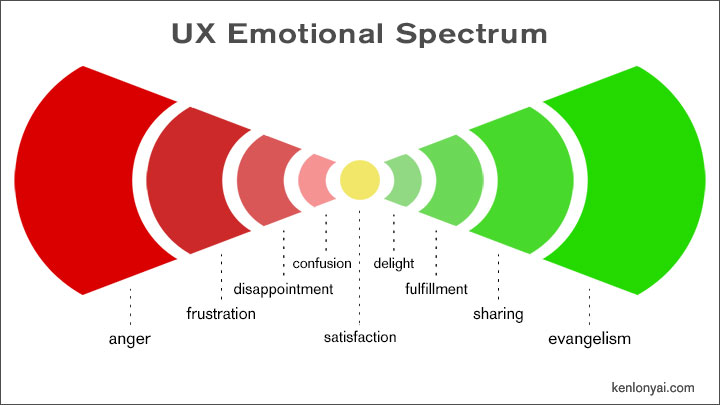UX Emotional Spectrum

Everything in life is an experience.
People, even animals seek out experiences that give them safety, comfort, fulfillment, and happiness. They avoid the opposite.
Product experiences are no exception. People seek out and return to those places and things that deliver delight.
Satisfaction, as in customer satisfaction, is merely a minimal level of acceptance [table stakes], to establish a product in the marketplace or at least maintain it there until satisfaction isn’t good enough. Satisfaction is a low bar and not a result to aim for.
Delight comes in various levels as visualized above. Delight increases to fulfillment which expands to sharing which culminates in evangelism. Every brand wants their products to be evangelized via “word of mouth” resulting in a “product that sells itself.” A product that has reached that level has for the most part exceeded user expectations and delivered such joy that users want to share their joy with others. Products at that level also tend to be the most profitable. People that seek delight and businesses that seek value, efficiency, or competitive advantage, consider price secondary to UX. Therefore, an evangelized product is minimally price sensitive* and reaches the level of evangelism from benefits users perceive from interacting with it.
Getting to that ultimate level or even producing a product that provides delight, is a function of understanding user needs and motivations [user-centered design] and delivering on it. It’s a very UX driven approach that fits the InnoProdUX framework and results in alignment between what is offered and what is useful to users. Evangelism is what products must strive for ultimately, but it very likely evolves over time from MVP through maturity through the tried and true iterative approach.
Heading down the negative path is obviously detrimental. It’s not just that customers and prospects are unhappy and can be lost. The impacts of each are multiplicative.
There’s also a kind of “evangelism” or more appropriately, ranting, venting, or retaliation on the negative side of the spectrum. Once a user heads into the frustration and anger end of the spectrum [maybe even earlier], they too are likely to share their bad experiences.
The cost of acquiring new customers both in dollars and time is far more expensive than retaining an existing one. Studies differ, but the cost basis for acquisition versus retention is likely a high single digit multiplier.
Attempting to patch up bad or weak user experiences through customer support teams is a Band-Aid over a serious wound. It covers it from view, but the problem is still unresolved and open to infection.
The UX Profitability Continuum encapsulates how profit is a direct function of UX. It’s validated by financial results that correlate with where users land on this spectrum. Both paths away from satisfaction equate to profitability, therefore profits are reflected more dramatically the farther out from center net user perceptions fall, be that negative or positive. Think of NPS [net promoter score] as an easy indicator.
To summarize: humans are emotional beings. Research has shown that often, sales are made more by emotion than logic. Focus on UX. Always think in terms of InnoProdUX. Appealing to users’ best emotions is a win-win scenario.
* Those rare products that meet industry norms but are price advantaged may get the evangelism boost based on price, but it’s a tentative position to maintain.
